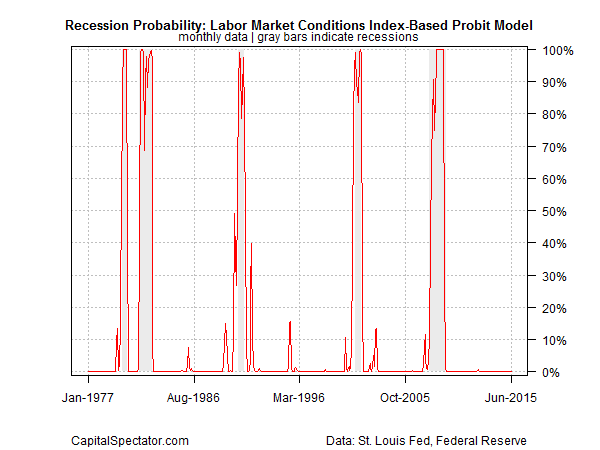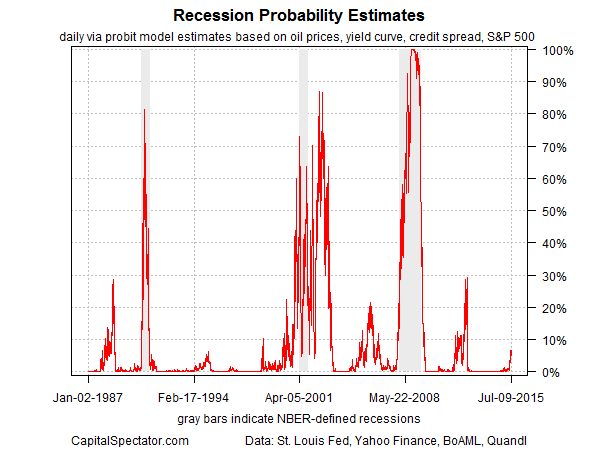There’s renewed talk of a looming U.S. recession these days. One argument that’s topical is the view that we’re overdue for a downturn. The current expansion, which began in mid-2009 (based on NBER data) is now six years old, which ranks as above average for the post-World War II era. It’s debatable if the age of expansions in isolation is truly a factor that determines the timing of contractions. Financial and economic context, in other words, is critical. Meantime, some economists argue that because the recovery from the Great Recession has been slow, the length of the expansion will be longer than usual. In any case, the current profile suggests that recession risk is low, based on the published numbers to date.
Monitoring recession risk requires a number of techniques, including a review of labor market trends. Let’s consider how the business cycle looks from three perspectives: jobless claims, the Federal Reserve’s Labor Market Conditions Index, along with a markets-based estimate of recession risk. Running the numbers through a probit model suggests that the probability is low that NBER will declare June 2015 as the start of a new recession. We’ll have a clearer view of how last month stacks up when I update the Economic Trend & Momentum indices later in July. Meantime, the early clues suggest that macro risk is still low for the US.
Let’s start with jobless claims. Based on monthly averages of this leading indicator, recession risk probability is under 5% at the moment.

A similar message emerges from the Fed’s Labor Market Conditions Index, a dynamic factor model that analyzes 19 indicators. Using this benchmark as a guide implies that recession risk was virtually nil as of last month.

Finally, consider a real-time approximation of economic conditions via a probit model that crunches the numbers on four data sets: the U.S. stock market (S&P 500); the Treasury yield curve (10-year yield less the 3-month T-bill yield); the credit spread (BAA-rated bond yield less AAA yield); and spot crude oil prices (based on the US benchmark, West Texas Intermediate). The current estimate with this analysis still points to growth. The probability that an NBER-defined recession has started for the U.S. according to this index has ticked higher lately, but it’s still quite low at present, below 10% as of July 9.

The overall message is that it’s unlikely that a new recession started in June. That’s an encouraging clue for anticipating that CapitalSpectator.com’s monthly review of conventional economic numbers through last month (once all the figures are published) will tell a similar story.
Yes, macro conditions could change quickly, and perhaps for reasons that aren’t captured in the data. That’s a reminder that ongoing and frequent analysis is essential. But for the moment, the case for arguing that the U.S. economy is stumbling requires a fair amount of speculation and guesswork.
Analyzing the market-price components separately offers a real-time approximation of macro conditions, according to the “wisdom of the crowd.” Why look to the financial and commodity markets for insight into the economic trend? Timely signals. Conventional economic reports are published with a time lag. MMRI is intended for use as a supplement for developing real-time perspective until a complete data set is published for updating the monthly economic profile.
